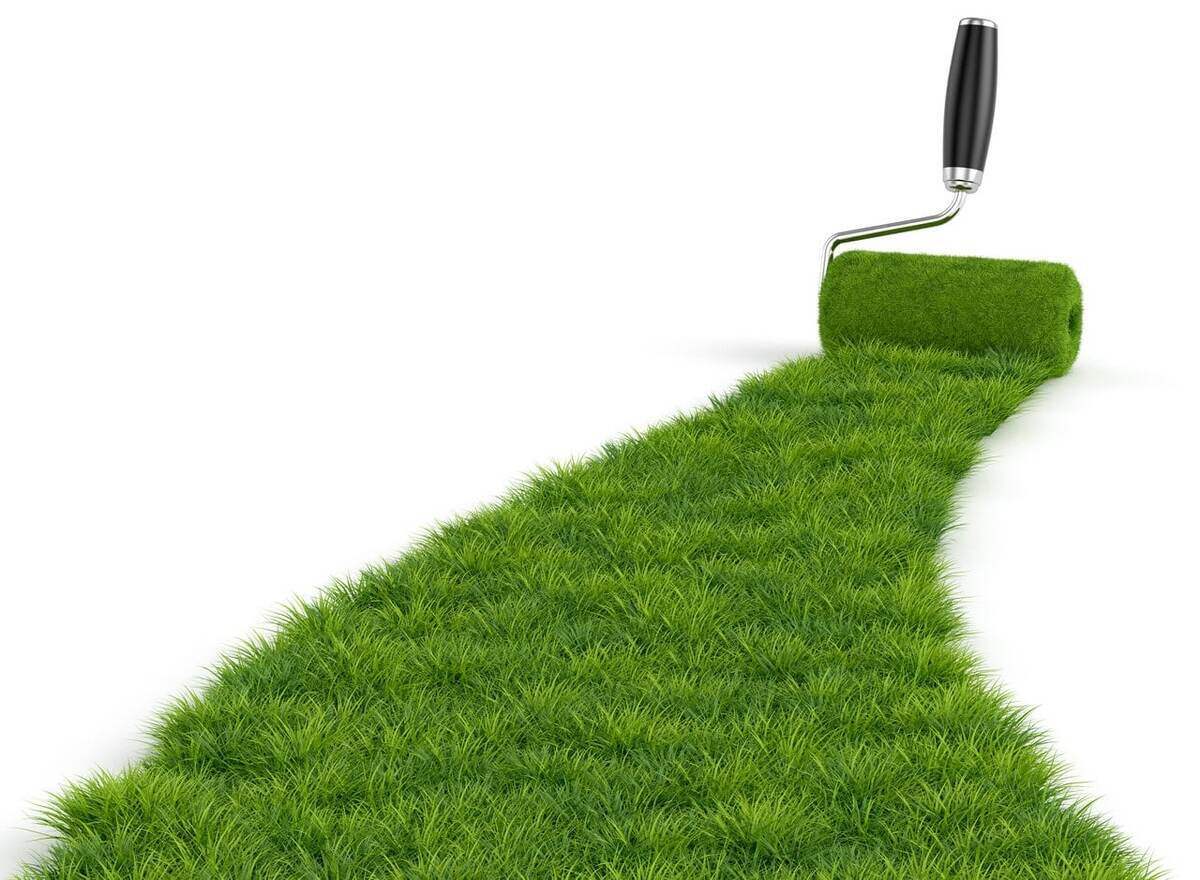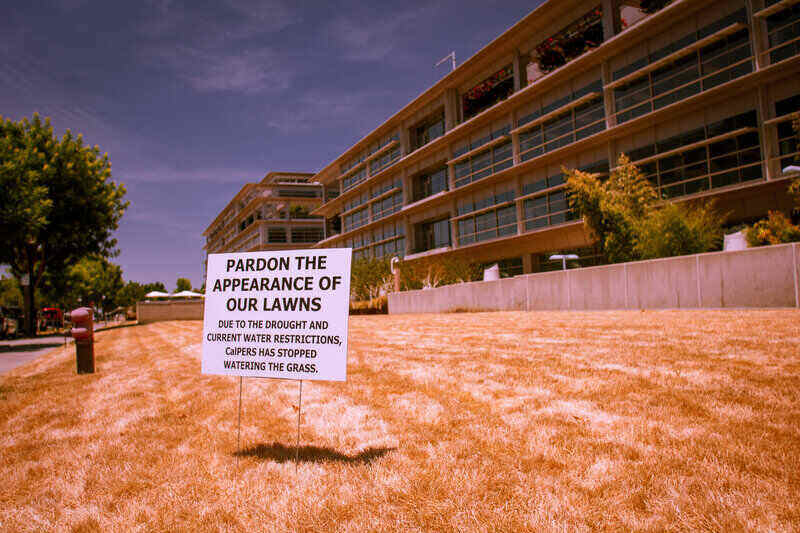
Does your lawn look more like January than September? Want to keep it looking its green best instead of browning out during a drought or in winter? Grass paint to the rescue! In this article, we’ll explain what grass paint is and how to paint your lawn to keep it green no matter the weather or time of year.

Popular Grass Paints
So, is it as easy as it sounds? Yes, the sales pitch is true: Lawn paint will have your lawn looking a verdant green in just a couple of hours without intensive work or breaking the bank.
“It’s a great do-it-yourself project; you can get into it relatively easily,” says Grady Miller, professor and Extension specialist with North Carolina State University (NCSU). “Next thing you know, you’re Picasso.”
Here are our top picks for the best grass paints for your lawn:
A Short History
Although you may not have heard of grass paint before, it’s not a new idea. In recent years, many Southern golf course managers have opted to use grass paint to save time, money, and hassle during the winter. Grass paint keeps putting greens a consistent green without the playability issues that arise from overseeding with perennial ryegrass.
From golf courses, the practice of spray painting grass spread to residential neighborhoods where homeowners saw the potential for savings, as well. Who doesn’t want a green lawn without overseeding in the winter or high water bills in the summer?
Lawn Paint: What It Is
Green grass paint is a non-toxic pigment that adds color to grass. Many people use products to paint or dye their lawns to give dormant, browning lawns a uniform and healthy-looking green color or to cover brown spots. Lawn paint goes by several names, including “turf paint”, “grass dye” and “turf colorant.”
Grass paint is:
- Environmentally friendly: Green lawn paint is made of non-toxic, biodegradable materials such as pulverized kaolin (a soft stone) and decayed plants.
- Kid and pet safe: The painted grass is safe for use by kids and pets once the lawn paint has dried.
- A long-lasting colorant: The color won’t rub off on your clothes, run on misty mornings, or be washed away by rain.
- An affordable option: Lawn paint will keep your lawn lush with green grass all winter, much like overseeding, but it’s cheaper.
- An overseeding alternative: Green lawn spray and paint, as a guide from the NCSU Extension says, serves as the standard alternative to overseeding warm-season grasses in the fall.
- A water-wise option: Grass colorant will keep your cool-season grass green with less water in the summer months.
Grass Paint: What It Isn’t
Grass paint differs from store-bought paint and other lawn care practices you may be familiar with. Here are a few things to keep in mind when painting your lawn.
Grass paint is not:
- Not vanity: Painting your lawn may help the dormant grass endure the weather in cold winter months.
- Not regular paint: Green paint for grass is special, not regular spray paint on the shelf at your local hardware store.
- Not hydroseed: This viscous spray is used by contractors as a less expensive way to establish a large, new lawn, as hydroseeding costs are generally more affordable. It’s a mix of seed, fiber mulch, and fertilizer sprayed to help a lawn get established.
- Not a cure for a dead lawn: If your lawn has died, painting over the dead grass will keep it looking decent for a while. Ultimately the grass will deteriorate to the point where it’s entirely dead. You’ll need to remove it and reseed your lawn once your lawn has died.
- Not life support: While green grass dye will reduce the amount of water your lawn needs, applying just enough water to keep the turf alive during a drought is ideal until the situation improves.
The best advice is to water the lawn one-quarter to one-half inch every two to four weeks when it’s dormant.
Grass paints have not been as popular among homeowners as they are with pros due to product availability and because many are unaware of the alternative.
Why You Should Use Grass Paint

Miller says, “It’s an aesthetic type of product,” he says. “By and large these are going to be used for a more-attractive” lawn.
- Hides problems: Professional landscape and lawn care companies use colorants to hide blemishes from pet urine and stress from disease. Yard paint is also used on drought-stricken grasses or during periods of water restrictions to present a more even appearance.
- Increases surface temperature: This aids plant growth during the cold weather to come.
- Lower maintenance: Lawn spray painting protects the grass from drought and high heat as an alternative to putting more fertilizer and water into the soil.
Before you give your brown grass a new coat of summer green, consider the paint (is it better to buy it or make it?) the preparations, the precautions, and the techniques.
The Paint: Choose the Right Product
The first step, Miller notes, is choosing the right paint. Take time up-front to select the right paint for your lawn’s size, grass color, and condition to enjoy a greener, longer-lasting color in the end.
Where to Buy
You will likely have to go to a commercial supplier or turn to the internet to get green dye for grass; although, local hardware retailers may carry it in-store. A quick search of Amazon and company websites turns up plenty of lawn paint options for the ambitious homeowner.
Application
Products such as LawnStar, EnviroColor, and Lawnlift grass paint offer options in both concentrated form and ready-to-spray bottles.
For brown, dormant lawns, treatments with a higher rate of application are preferable. On grass that is still green but might use a little color, a grass spray paint with lower application rates performs better.
How Much to Buy
On average, a 32-ounce bottle will run you about $20. That’s enough to cover 500-1,000 square feet, according to LawnStar.
Buying in bulk often saves you some money. A 1-gallon jug from manufacturer Endurant sells on Amazon for $95. That’s enough to cover 10,000 square feet of lawn.
Many times, though, product labels aren’t very clear as far as rates and application, Miller says. So you may have to experiment with what works well for your situation.
How Long Does Grass Paint Last?
Grass paint should typically last between 2 and 3 months. If the grass is dormant, the paint will appear to fade when it begins to grow again. Rain, mowing, and heavy foot traffic can all degrade the spray paint on your grass.
- Lawnlift, which also makes mulch paints to spruce up the look of last year’s fading mulch, says its grass paint products last up to three months, depending on how often you mow.
- Endurant says their turf paint will typically last 6 to 8 weeks. Because colorant is removed by mowing, when applied to dormant turf, it lasts longer than when applied to turf that is actively growing.
- EnviroColor states that their grass colorant lasts up to two months depending on the condition of your lawns.
Make Your Own Lawn Paint
If those prices seem steep for covering a few dead spots in your lawn, you can make your own spray paint for grass at home.
You’ll need a few things to get started when making your DIY green grass paint.
Materials:
- Epsom salt
- Liquid fertilizer
- Green food coloring.
How to mix:
For a small to medium-sized yard – Mix one pound of fertilizer with four pounds of Epsom salt and one-quarter cup of green food coloring.
Pro tip: Epsom salt adds magnesium and iron to the lawn. This may not be the best idea if you’ve got a healthy soil nutrient balance. If that’s the case, simply replace the Epsom salt with water. It’s the food coloring that serves as the grass dye.
How to Paint Your Grass
The Preparations
So you’ve got the paint. What now?
What you need:
- Lawn paint
- Backpack, lawn, or pump sprayer
- Garden hose with running water
For best results:
- Grass should be mowed and dry: Painting your grass when it still has dew may improve the outcome of the color. If your grass is extremely dry, the grass blades will absorb the paint, so you will need more paint per square foot.
- Set sprayer to fine mist: Get the best coverage on the finest setting and give the whole sprayer a shake periodically. This will avoid the pigment settling and the nozzle clogging.
- Good weather: Apply the grass color spray on a sunny day with no wind. Puddles of water will dilute the application, give you an off-color, and extend drying time.
- Pay attention: Make sure you follow the manufacturer’s instructions and product information to get the correct concentrate-to-water ratio.
You should mask off any areas you don’t want to turn green. A cardboard screen or other splash guard will protect those surfaces.
Don’t wait until your grass is entirely straw-brown. The natural green lawn color of active turf will greatly enhance any paint or colorant you add. Miller says the greener the grass already is, the better it will take color.
The Precautions
Keep in mind that lawn paint is paint, and it will color whatever it touches.
Take precautions:
- Wear protective eyewear, gloves, and a breathing mask.
- Keep a bucket of soap handy with a wire brush to remove any accidental overspray quickly.
- Wear old shoes you don’t mind getting stained.
Miller says he’s seen golf courses turn their tee markers green, and urged caution around places such as driveways or the walls of your house.
“Most of these [stains] are permanent,” Miller warns, especially on porous, hard surfaces like concrete. “If you paint your sidewalk green, it’s going to stay green.”
The Techniques: 5 Tips for Grass Painting
- Paint a test spot. In an out-of-the-way corner of your lawn, try the paint out to make sure you get the right color. You may need a couple of passes for a darker green, or to dilute the mixture to lighten it up.
It’s like painting a wall, Miller says. If you don’t feel like you’ve got good coverage, go over it again.
- Spray consistently. Spray about 6 to 8 inches from the surface in a sweeping, overlapping motion. In areas bordering driveways or other surfaces you don’t want to paint, pour some of the mixtures into a small spray bottle for greater accuracy.
- Avoid striping. Spray the lawn green in a random, orbital pattern. This will keep the paint from striping and give the lawn a more even, natural look.
- Clean up immediately. Once you’re finished, immediately clean your sprayer until the water comes out clear. Also, clean up any stained concrete or other surfaces quickly before the paint is fully dry.
- Let it dry completely. Check the manufacturer’s recommended drying time. You may be able to get back out in your yard in as little as 60 minutes, or you may have to wait as long as 24 hours for the lawn to dry in very humid conditions.
The smell should also dissipate automatically, so there’s no need to take precautions as you would when painting indoors.
Sources: Lawnlift and Envirocolor
Keep in Mind
Miller offers some more advice, saying that the products do fade and wear over time, and some fade is less attractive than others.
To get the green grass color, he says companies mix blue and yellow pigments. It seems like the yellows fade quicker, leaving the blue behind. And Miller says that once it gets too blue — think Smurf blue —it’s too late to turn it back green. The trick is to reapply the colorant before the paint fades too much.
FAQ
1. Can I Walk on Painted Grass?
Yes. Once the paint has fully dried, it’s safe to be on. Lawn paint can dry in as little as an hour, but it can take up to 24 hours in high humidity conditions.
2. What Happens to Lawn Paint if it Rains?
As long as the paint has fully dried on your grass, the rain will not affect it.
3. Can Grass Paint Kill my Grass or Hurt my Pets?
No. The paint won’t damage your lawn, and once dried, it’s safe for the whole family, including your four-legged friends.
4. Are There Downsides to Painting Your Lawn?
Grass paint will hide problems in your lawn but not fix them. Lawn paint doesn’t provide a wearable surface, meaning if the paint wears off in a spot, the green stays gone and your lawn looks brown again. Also, it will stain anything it touches, including sidewalks and you, so be careful as you apply.
When to Call a Professional
Maybe that all sounds like a daunting task for a first-timer. Don’t worry, lawn care services and professional landscapers will also handle this one for you. But one thing’s for sure: After a successful coat of paint, you’ll have the greenest lawn on the block in no time.
Additional source: Hunker
* Editorial Note: LawnStarter participates in the Amazon Services LLC Associates Program, an affiliate advertising program. LawnStarter may earn revenue from products promoted in this article.
Main Image Credit: dencg / Shutterstock